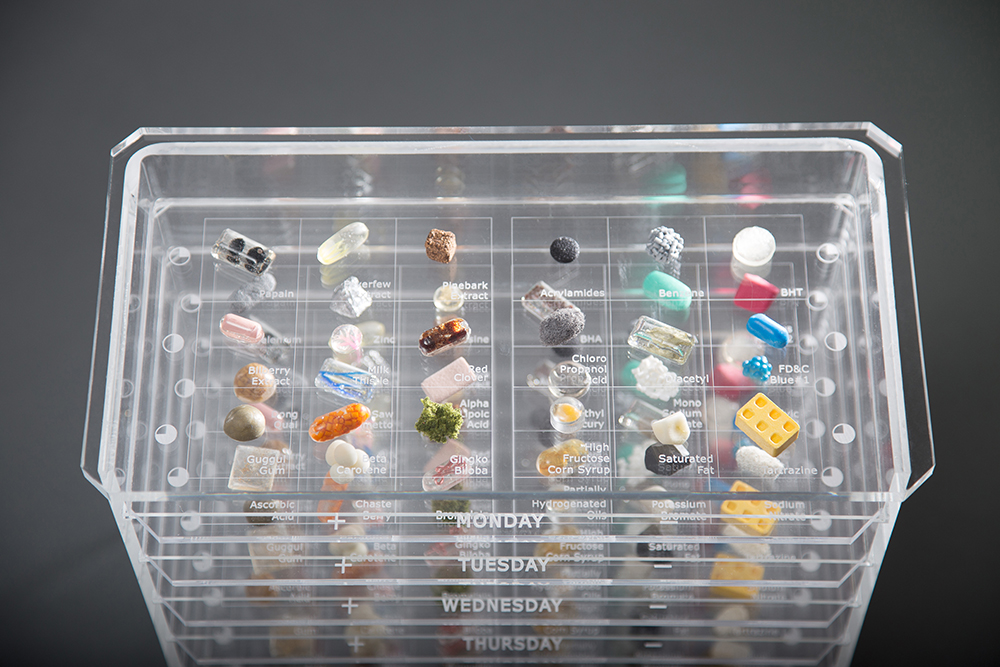The Emergence of Speculative Design
“I’ve never thought of myself as a problem solver,” said Jessica Charlesworth in reference to her career as a designer. Her work takes forms like toy models of dopamine neurotransmitters and survival kits that come in plastic bags with giant smiley faces on them.
“We are interested in how objects can be designed with a level of awareness of their position in the culture that allows those objects to provoke … and to reveal new possibilities,” Tim Parsons, Charlesworth’s husband, said at a recent Core 77 conference in New York.

Anthony Dunne and Fiona Raby pioneered speculative design in the ‘90s. It challenges design’s “inherent optimism” and the idea that huge challenges “can be broken down, quantified, and solved,” explains Speculative Everything, Dunne and Raby’s 2013 publication. Instead, speculative design can “create space for discussion and debate about alternative ways of being … [by acting] as a catalyst for collectively redefining our relationship to reality.”
Speculative Everything holds a remarkable collection of works that challenge design’s conventional methods. Victimless Leather (2004-13) by Oron Catts and Ionat Zurr featured lab-grown tissue in the shape of a jacket that had to be kept alive during a MOMA exhibition and eventually euthanized when it grew out of control. Carnivorous Domestic Entertainment Robots (2009) by James Auger and Jimmy Loizeau look like furniture and “convert organic matter [around the house] like insects into energy.”
This method of design shies away from design for mass consumption, which relies on generalizing about groups of people to create one profitable solution. Charlesworth explained her past jobs in design consulting and service design as something she found “ethically difficult.”
Dunne and Raby addressed a similar concern ten years ago when they structured a program at Royal College of Art that considered the implications of design itself (Charlesworth was one of their students). Italian Radical Design of the 1970s influenced Dunne and Raby, and shows like The New Domestic Landscape at MOMA in 1972 featured bathtubs made of plastic and aluminum houses that could easily be resized, all of which were questioning the role of “the object.” The Graham Foundation in Chicago recreated the show last year in recognition of Italian Radical Design’s emerging influence.
More than forty years later, displaying works of the speculative realm raises nearly as many questions as the works themselves. “We are interested in multiple platforms,” said Charlesworth in reference to her and Parson’s projects. Their survival kit project will take place at the 2014 Istanbul Design Biennial. The series of “alternative survival kits for short-term evacuation after a disaster,” is comprised of sets of objects meant to act as comfort blankets, according to Charlesworth’s website, “for our uncertain future, revealing our deepest hopes, fears and convictions at the most critical moment. This project … asks ‘what alternative scenarios of survival are there that avoid the bunker mentality and respond to currently emerging research into technological change, environmental conditions and belief systems?’”
The recent CHGO DSGN show at the Chicago Cultural Center housed Charlesworth’s MeMo Organisation project (2013), which focused on “dying and mourning and new rituals of thinking about loss and commitment.” The exhibit included works like the mold of a face meant to leave an imprint in the pillow where a loved one once slept.

Short stories written through the views of fictional characters that used the devices accompanied each piece in the MeMo project. Charlesworth attributed the individual perspectives in the stories to her time in design research, which required pulling themes from groups of people and considering the types of individuals that would be using the product.
Speculative Everything emphasizes fiction’s role in contextualizing speculative objects. It explains writing as a way for the object “‘to tell worlds rather than stories,’ as Bruce Sterling so aptly puts it.”
The bizarre nature of many speculative objects benefits from the use of text to add thematic and emotional components that build connections with viewers. However, the text isn’t meant to give
the entire concept away. “It’s not like an introduction to the object, it’s more like you’re halfway through the story. … I want [these objects] to be in another time or another place that isn’t related to you or me,” said Charlesworth.
There’s a section titled “Compasses Not Maps” in Speculative Everything. The simple phrase provides a strong visual for design’s potential to help us envision the future not as a continuation of the present but as something that doesn’t need to be based off what we know at all. Can this method gain precedence in a world geared toward mass consumption?
“[In the United States] imaginative and speculative approaches to design are too-often dismissed, either as art, or as decadent and irrelevant, when in fact, history shows they can be the seeds to whole new behaviors, policies, or product lines,” said Parsons during Core 77.
Synthetic biology, for instance, often employs speculative design to evoke dialogue around ethical issues. Christina Agapakis recently made headlines with cheese made by human bacteria, entitled Selfmade (2013). It has been exhibited in various settings, and viewers are cautioned that it is not for consumption. Food not meant to be eaten will almost always spark questions. “These cheeses are scientific as well as artistic objects, challenging us to rethink our relationship with our bacteria and with our biotechnology,” says Agapakis on her website.
Works like Selfmade give some perspective, but the role of speculative design in fields like science and technology still remains cryptic. “I don’t know what the future of this particular approach to working is,” said Charlesworth. “I just want people to think differently about their role as a designer or practitioner.”
Speculative design’s future is speculative, which may not be a bad thing. After all, adopting a comfortable position in society would defy everything it stands for.







